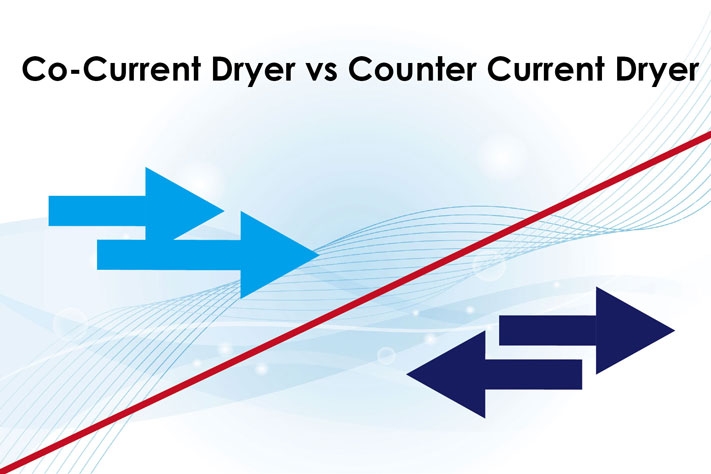Co-Current vs Counter Current Drying

Co-Current System
In general, the co-current system is suitable for heat-sensitive materials. It has good control over solids’ temperature and will reduce the chance of overheating. However, it is less thermal efficient when compared to the counter current system.
Advantage
Rapid removal of surface moisture
Advantages include the rapid removal of free moister. It can generate a quick initial reduction of moisture in the drying process. Therefore, is efficient with materials that have high surface moisture such as glass.
Ideal for heat sensitive-materials
Heat sensitive materials are less tolerant to heat, when overheated it can cause unwanted color changes, substrate cracking, substrate deformation and product degradation. Co-current system is designed in a way that the hottest air is in contact with the wettest phase of the material, and the hot air temperature will decrease with the material as they move through the dryer. This type of design allows an easier control over the temperature and therefore reduces the chance of overheating.
Disadvantage
Less efficient drying system
In the co-current drying process, we need to ensure the temperature of the air that contacts the solids exceed the temperature of the solids. To maintain this type of environment in the co-current system will require more energy. Therefore, making it less energy efficient.
Counter Current System
In general, the counter current system is suitable for materials that hold on tight to moisture and requires heating to a higher temperature in order to dry. However, the counter current drying system has less control over solids’ temperature and has more risk of overheating.
Advantage
Gradual removal of surface moisture
Drawing out tightly bounded moister from the material requires gradual heating instead of injecting high heat initially and then leveling off. The counter current design will allow the material to get heated gradually and finally come into contact with the hottest air during the material’s most dehydrated state. Therefore, counter current drying system is ideal for materials that are bound tightly to moisture.
Greater thermal efficiency
In a counter current drying system, the air temperature is not required to be higher than the solids. Therefore, less heat is spent on ensuring the exhaust gas temperature remains high.
Disadvantage
Less control over solids temperature
The opposing flow of the solids and exhaust gas in the counter current configuration makes it more difficult to control the temperature of the solids.
Risk of overheating
Overheating of the materials is more likely to occur since the solids come into contact with the hottest gas at their most hydrated state.
Besides knowing the advantages and disadvantages of the co-current drying system and the counter current system it is also important to decide whether you would like to impose a combustion chamber to prevent direct contact between the burner frame and the material being processed. This will reduce the chance of overheating. Furthermore, a combustion chamber will allow heated air to be recycled from the drying and will save energy. Come talk to a KYMC representative to discuss about your drying requirements.
Relevant Reading
Breakdown the Drying Process

Article by Daywey Chen, KYMC


























